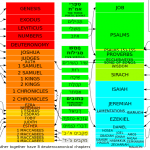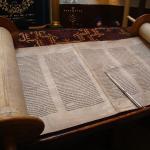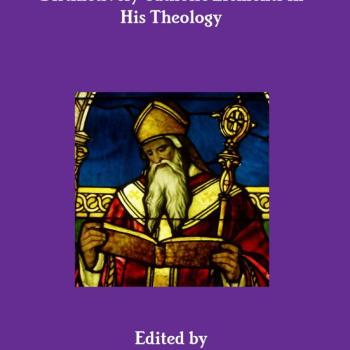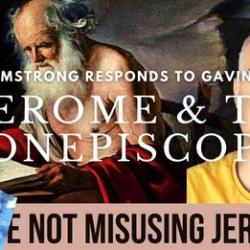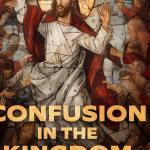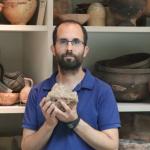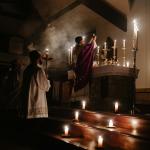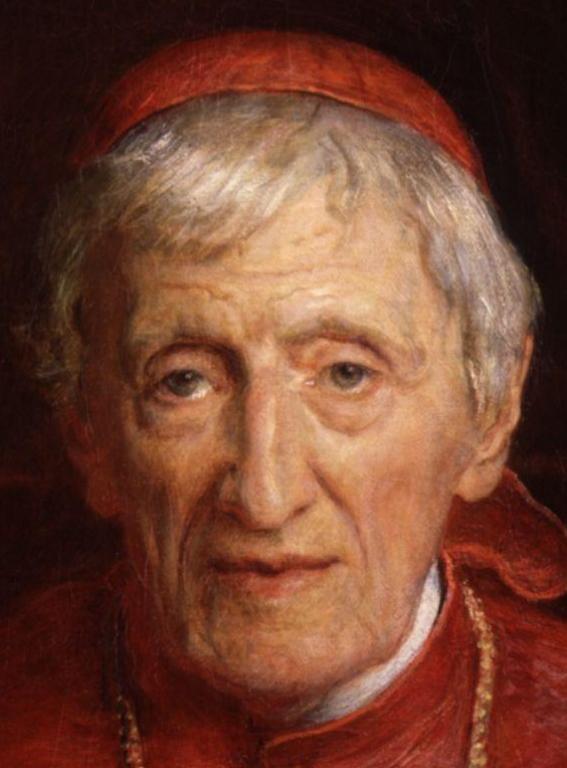
A false assumption is often made by anti-Catholics and other critics of the Catholic Church, that when Catholics discuss how something has “always been believed,” that they are not also often referring to adherence to implicit or kernel-forms or the “acorns” or “seeds” of development of doctrine (i.e., they are referring to the essence of the doctrine, which was received from the apostles and never changes). This misunderstanding is based not only on ignorance of development of doctrine per se, but on gross neglect of the larger context of papal and conciliar utterances.
To use one illustrative example: if the Immaculate Conception had always been believed precisely as Pius IX was defining it — i.e., as the full-fledged, fully developed doctrine, as developed by 1854 — then he would not have to define it in the first place. Such ex cathedra proclamations of the extraordinary magisterium, by their very nature, presuppose that much development has taken place over time.
I have provided thorough background documentation as to the Church’s teaching on development of doctrine through the centuries.
Blessed Pope Pius IX, in the very same document where he defines the Immaculate Conception as an infallible doctrine (ex cathedra), also refers to development of doctrine:
. . . For the Church of Christ, watchful guardian that she is, and defender of the dogmas deposited with her, never changes anything, never diminishes anything, never adds anything to them; but with all diligence she treats the ancient documents faithfully and wisely; if they really are of ancient origin and if the faith of the Fathers has transmitted them, she strives to investigate and explain them in such a way that the ancient dogmas of heavenly doctrine will be made evident and clear, but will retain their full, integral, and proper nature, and will grow only within their own genus — that is, within the same dogma, in the same sense and the same meaning. (Apostolic Constitution Ineffabilis Deus, December 8, 1854; in Papal Teachings: The Church, selected and arranged by the Benedictine Monks of Solesmes, translated by Mother E. O’Gorman, Boston: Daughters of St. Paul, 1962, 71)
Supposedly, the First Vatican Council, according to anti-Catholic polemicists William Webster and Jason Engwer, was opposed to any development, at least where it concerns papal infallibility, which it defined as an infallible doctrine. This is ludicrous, because the same pope who convoked it and ratified its proclamations, also wrote (in the very letter of convocation of the Council, to the bishops):
Pontiffs have not neglected to convoke General Councils in order to act with and unite their strength to the strength of the bishops of the whole Catholic world . . . to procure in the first place the definition of the dogmas of the faith, the destruction of widespread errors, the defense, illumination, and development of Catholic doctrine . . . (Apostolic Letter Aeterni Patris, June 29, 1868; in Papal Teachings: The Church, 193)
In the same year of the Council, Blessed Pope Pius IX wrote:
Religion is in no sense the enemy of progress . . . If there is an immobility which in fact she cannot renounce, it is the immobility of the principles and doctrines which are divinely revealed. These can never change . . . [Heb 13:8] But for religious truths, there is progress only in their development, their penetration, their practice: in themselves they remain essentially immutable . . . All the truths divinely revealed have always been believed; they have always been a part of the deposit confided to the Church. But some of them must from time to time, according to circumstances and necessity, be placed in a stronger light and more firmly established. This is the sense in which the Church draws from her treasure new things . . . [Matt 13:52] (Allocution to the Religious Art Exposition, Rome, May 16, 1870; in Papal Teachings: The Church, 208)
In all this, Pius was merely reflecting (note the very similar wording in his first statement above: “same dogma, in the same sense and the same meaning”) the constant teaching of the Church, as stated classically by the 5th century St. Vincent of Lerins (whom the same council cited, in its explicit espousal of development of doctrine):
[6.] Moreover, in the Catholic Church itself, all possible care must be taken, that we hold that faith which has been believed everywhere, always, by all. For that is truly and in the strictest sense “Catholic,” which, as the name itself and the reason of the thing declare, comprehends all universally. This rule we shall observe if we follow universality, antiquity, consent . . .[54.] But some one will say. perhaps, Shall there, then, be no progress in Christ’s Church? Certainly; all possible progress . . . Yet on condition that it be real progress, not alteration of the faith. For progress requires that the subject be enlarged in itself, alteration, that it be transformed into something else . . . but yet only in its own kind; that is to say, in the same doctrine, in the same sense, and in the same meaning.
[55.] The growth of religion in the soul must be analogous to the growth of the body, which, though in process of years it is developed and attains its full size, yet remains still the same. There is a wide difference between the flower of youth and the maturity of age; yet they who were once young are still the same now that they have become old, inasmuch that though the stature and outward form of the individual are changed, yet his nature is one and the same, his person is one and the same . . . nothing new is produced in them when old which was not already latent in them when children. This, then, is undoubtedly the true and legitimate rule of progress . . .
[56.] In like manner, it behooves Christian doctrine to follow the same laws of progress, so as to be consolidated by years, enlarged by time, refined by age, and yet, withal, to continue uncorrupt and unadulterate, . . . admitting no change, no waste of its distinctive property, no variation in its limits.
[57] . . . when in process of time any of the original seed is developed, and now flourishes under cultivation, no change may ensue in the character of the plant. There may supervene shape, form, variation in outward appearance, but the nature of each kind must remain the same . . . They may receive proof, illustration, definiteness; but they must retain withal their completeness, their integrity, their characteristic properties. (The Commonitorium [Notebooks] )
There is no contradiction here at all. The only contradiction and confusion resides with these anti-Catholic critics, who either don’t understand development in the first place, or refuse to learn what the Catholic Church in particular teaches about it, and how it relates to the definition of dogma. This ignorance and misinformation about doctrinal development (especially Cardinal Newman’s formulation of it) amongst anti-Catholic polemicists is unfortunately widespread. It is a sad instance of “theological tunnel vision” at its worst.
St. Thomas Aquinas accepted all these “fine distinctions,” as I thoroughly documented:
It was necessary to promulgate confessions of faith which in no way differ, save that in one it is more fully explicated which in another is contained implicitly. (Summa Theologiae [ST] 1, q.36, a.2 ad 2)And so it is no wonder, after the rise of various errors, if modern teachers of the faith speak more cautiously and seemingly perfectly concerning the doctrine of faith so that all heresy might be avoided.Hence, if some things in the writings of ancient teachers is found which is not said with as much caution as maintained by moderns, they are not to be condemned or cast aside; but it is not necessary to embrace these things, but interpret them reverently. (Preface to Contra errores Graecorum)
What therefore in the time of ancient councils was not yet necessary is posited here explicitly. But later it was expressed, with the rising error of certain people, in a Council gathered in the West by the authority of the Roman pontiff, by whose authority the ancient councils were also gathered and confirmed. It was contained nevertheless implicitly when it was said that Holy Spirit proceeds from the Father. (ST 1, q.36, a.2 ad 2)
[A]ccording to 1 Cor. 1:10: “That you all speak the same thing, and that there be no schisms among you”: and this could not be secured unless any question of faith that may arise be decided by him who presides over the whole Church, so that the whole Church may hold firmly to his decision. Consequently it belongs to the sole authority of the Sovereign Pontiff to publish a new edition of the symbol, as do all other matters which concern the whole Church, such as to convoke a general council and so forth. (ST 2-2, q.1, a.10 [” Whether it belongs to the Sovereign Pontiff to draw up a symbol of faith?”]; see too Yves M.-J. Congar, O.P., “Saint Thomas Aquinas and the Infallibility of the Papal Magisterium” The Thomist 38 [1974] 81-105)
We find precisely the same thought process and paradigm (as in St. Vincent, St. Thomas Aquinas, Blessed Pope Pius IX, and Blessed Cardinal Newman) in Venerable Pope Pius XII, who infallibly defined the Bodily Assumption of Mary ex cathedra in 1950. In that same year, within three months of his definition, in another well-known and important encyclical, he wrote:
. . . theologians must always return to the sources of divine revelation: for it belongs to them to point out how the doctrine of the living Teaching Authority is to be found either explicitly or implicitly in the Scriptures and in Tradition. Besides, each source of divinely revealed doctrine contains so many rich treasures of truth, that they can really never be exhausted. Hence it is that theology through the study of its sacred sources remains ever fresh . . . together with the sources of positive theology God has given to His Church a living Teaching Authority to elucidate and explain what is contained in the deposit of faith only obscurely and implicitly. (Encyclical Humani Generis, August 12, 1950; in Papal Teachings: The Church, 659)
And in the very proclamation which contained the definition itself, he stated:
. . . the Universal Church, within which dwells the Spirit of Truth who infallibly directs it towards an ever more perfect knowledge of the revealed truths . . . (Apostolic Constitution Munificentissimus Deus, November 1, 1950; in Papal Teachings: The Church, 318)
***
(originally 3-19-02)
Photo: Blessed John Henry Cardinal Newman
***


